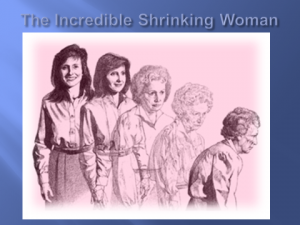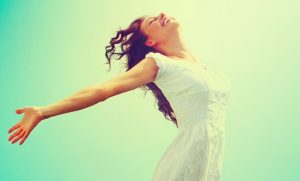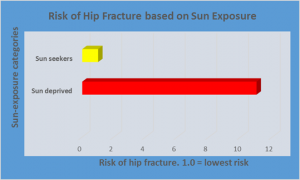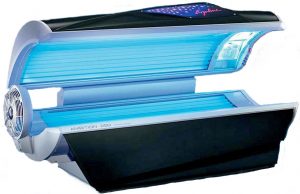Bone, vitamin D supplements, and sunlight By Marc Sorenson, EdD.
Bone and vitamin D are connected, yet, it may not be in the way you think. It is probably common knowledge that vitamin D is necessary for bone strength, particularly rickets. Yet, beyond rickets, it is not settled science that supplements significantly improve bone strength.
To prove this point, and to cause thoughtful consideration, I call your attention to a meta-analysis of 23 studies. The research assessed change in bone density (BD) from measurement inception to completion of each experiment. The bone densities measured the lumbar spine, femoral neck, total hip, trochanter, total body, or forearm. In addition, all participants took vitamin D supplements. There was little observable change in BD, so the results were disappointing. Thus, the researchers reported, in conclusion, “Continuing widespread use of vitamin D for osteoporosis prevention in community-dwelling adults without specific risk factors for vitamin D deficiency seems to be inappropriate.” Yet, before you give up on vitamin D for bone, let us consider the weakness of the research.
Does bone require much more than 800 IU per day to increase bone strength?
In 10 of the 23 studies cited above, the vitamin D dosage was less than 800 IU per day. This is rather like throwing a packet of food coloring into the sea and expecting the sea to turn red. Direct full-body sunlight during 10-15 minutes can stimulate the skin to produce up to 20,000 IU of vitamin D. Sunlight is the natural way to obtain vitamin D and numerous other healthful photoproducts. A minuscule dose of 800 IU will probably do little for bone strength. Yet, if the researchers had found studies using 3,000 and 5,000 IU, I could have more easily believed their conclusions. However, I could easily have been wrong, as you will see.
So are there other studies that make contradictory conclusions?
No. Most of the research using high-dose vitamin D supplements also had poor results. They usually resulted in much higher fracture risk for those taking the supplements. This was especially true in those who took large, intermittent doses and or intermittent intramuscular injections. Other data showed that doses of more than 4,000 IU daily are associated with more falls and fractures. In addition, research from the Journal of the American Medical Association showed an alarming trend. First of all, treatment with vitamin D for 3 years (4000 IU) day was counterproductive. Thus, it resulted in statistically significant lower bone mineral density (BMD) in certain bones. Furthermore, the same was true for 10,000 IU per day.
Are there better ways to keep bone strong?
Another factor to consider: vitamin D supplements may not be the same as vitamin D made by the human body. The skin always makes natural vitamin D for humans during exposure to sunlight and other sources of UVB light. Irradiating sheep’s lanolin produces the Vitamin D for supplements. Therefore, although 20,000 IU of vitamin D in 20 minutes is possible from sun exposure, the results are very different. Skin-produced vitamin D from sun exposure does not result in increased fracture risk and lower BMD.
The Spanish study on bone and sunlight
An important study from Spain shows that those who actively sought sun exposure had only 1/11 the risk of hip fracture compared to those who were not sun seekers! In this case, the sun-seeking people must have produced remarkable quantities of vitamin D. They also they increased bone strength remarkably. In addition, we know that the high vitamin D levels certainly caused no problem with bone density and bone strength! How can this be if high doses of vitamin D supplements lead to increased fracture rates? The difference, in my opinion, is the source.
Lessons learned, and conclusions
Therefore, we may take away important lessons from this treatise. First, vitamin D produced by sunlight is not the same as vitamin D from a pill. Moreover, vitamin D is a primary photoproduct of sun exposure. There is an exceptional difference between a pill produced from lanolin and a photoproduct produced in response to sunlight. If sun exposure can produce up to 20,000 IU of vitamin D, and it increases bone strength, something is awry with vitamin supplements, which decrease bone strength. We have produced evidence that show vitamin D supplements may increase bone fragility. It is time to accept the sun or other source of light as the major source of bone strength. That other source could be sunlamps or tanning beds.
A synopsis on bone and sunlight.
Finally, we must realize that sun exposure produces many photoproducts beyond vitamin D. Serotonin, endorphin, nitric oxide; brain-derived-neurotropic factor (BDNF) and dopamine are some of those photoproducts. All of them are vital to human health. Who is to say that these photoproducts do not form a synergistic relationship with sun-produced vitamin D to create the miracle of hip-fracture reduction? Do not neglect your regular, non-burning sun exposure. It may save your bones and your life.
Read more by visiting the Sunlight Institute, and read the book by Sorenson and Grant, Embrace the Sun. Happy Sunning!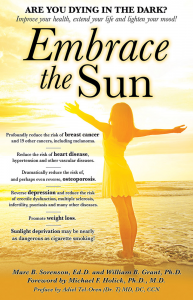
Sunlight or vitamin D or both? By Marc Sorenson, EdD.
Sunlight or vitamin D? That is a question that should not be necessary, yet many believe that vitamin D replaces sun exposure. So, they will state, “just take some vitamin D pills rather than go out in the sunlight, thus, you can derive sunlight benefits without the risk of skin cancer.” This opinion is incorrect, and it leads to sun deprivation.
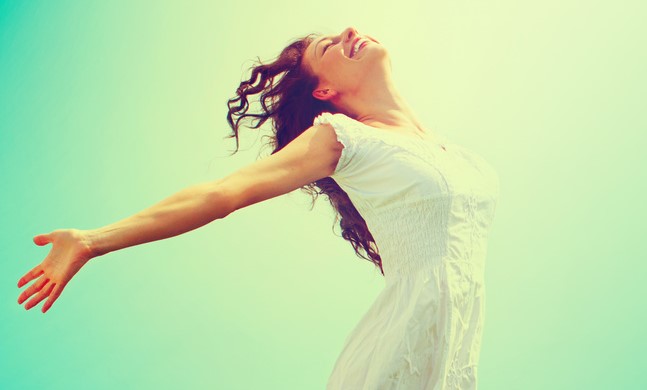
This poor opinion of sunlight is misguided, erroneous and dangerous.
First of all, sunlight leads to production of many photoproducts when it touches the skin or enters the eyes. (Do not stare into the sun, since sufficient sun enters the eyes by reflection from objects or from the sky). These photoproducts include serotonin, endorphin, vitamin D, dopamine, brain-derived neurotropic factor (BDNF) and nitric oxide.
Furthermore, all of these sunlight photoproducts are known to have healthful effects.
In addition, there are more photoproducts that are produced by sun exposure, but they have not yet been well-studied. Yet, it is likely that all of them will be found to have salubrious effects for the human body. Hence, we need them all. Obviously, a vitamin D pill cannot provide all the health benefits that sunlight provides.
Vitamin D in isolation may not always be healthful. Consider sunlight instead.
So yes, vitamin D is an important photoproduct of sunlight, but it is just one of the photoproducts. Thus, it is along for the ride with its companions. The serum blood tests which measure vitamin D are really surrogate measures for sunlight exposure and its other photoproducts. And, these photoproducts work as a team; one might say a “holistic” team.
Sunlight or vitamin D. What does the vitamin D research tell us?
A surprising piece of recent research assessed the efficacy of vitamin D supplementation on bone strength and density. The researchers worked with 311 healthy volunteers aged 55 to 70 and these volunteers were split into three groups. One group received 400 international units (IU) per day of vitamin D, and a second group received 4,000 IU per day. Finally, a third group received 10,000 IU per day. Bone strength and density were measured at the beginning of the investigation and at intervals of 6, 12, 24 and 36 months. The researchers had thought there would be an increase in bone mass, yet, the results were opposite of their expectations. Stunningly, all three groups lost bone mass, and the higher the vitamin D dose, the more rapid the bone loss!
How can this happen? Does sunlight exposure play a part?
So, we have an interesting dichotomy here. First of all, we see that isolated vitamin D (the supplements) were counterproductive for bone strength and mass. And yet, we know that low serum levels of vitamin D are associated with low bone density. Maybe we can unravel this mystery by mentioning that almost all serum vitamin D (about 90%) is produced by sun exposure on the skin.
Therefore, low vitamin D levels are really indicative of sunlight deprivation.
And as aforementioned, one isolated chemical (vitamin D), cannot possibly be expected to take the place of the holistic sun. Especially relevant is a study that found Spanish women who sunbathed had 1/11 the fracture risk of indoor women. Is there any doubt that the strong-boned women had higher vitamin D levels than their counterparts? You see, we have gotten it backward, because greater sun exposure associates with higher vitamin D levels and predicts long life and health. Sunlight leads to vitamin D production, but vitamin D does not bring sunlight and all its additional photoproducts.
Does vitamin D supplementation protect against cardiovascular disease (CVD), or is it sunlight?
We know the answer to half of that that question due to a study of more than 83,000 people. And this study was a meta-analysis. This means a compilation and analysis of the best supplementation studies. The study compared vitamin D intake with CVD events (heart attacks, stoke, death from CVD and all-cause death). The authors found, as a result, that vitamin D supplementation was not associated with CVD.
Most noteworthy is that for years, sunlight was shown to associate to a much reduced risk of CVD.
And, that included heart attack and stroke.
Many made the mistake of giving the credit for the reduced risk to vitamin D, because of this research.The answer to health is to embrace the holistic sun and not a single photoproduct.
Sunlight related to the beta carotene study
This reminds me of research on beta-carotene, an antioxidant nutrient found in orange and yellow vegetables such as carrots. Since these vegetables have healthful properties, the researchers decided to experiment with isolated beta-carotene. They wanted determine if beta-carotene also had anti-cancer properties. To their dismay, these experiments associated to an increase in cancer. Does isolated vitamin D lead to the same deleterious outcomes? Sunlight should also be used in its whole form, just like the carrot.
So in the winter, in climes where there is little sunlight, how do we get our share of life-saving light?
The best method is to use a good sunbed (tanning bed), and when the sunlight is available, to be outside enjoying it, summer and winter. Sunbed use has many life-enhancing effects, including longer life, stronger bones and better mood. Read more about sunbeds, sunlight, bone strength and health at http://sunlightinstitute.org/ and read the book by Sorenson and Grant: Embrace the Sun.
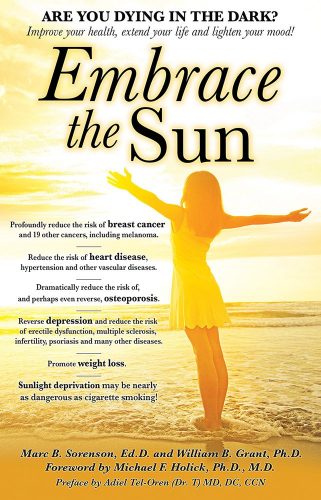
Happy sunning! And remember never to burn.
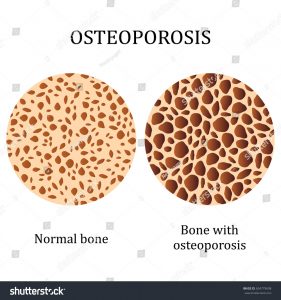 Bone needs vitamin D
Bone needs vitamin D
Bone is deteriorating in our society. Why? Since the year 2000, there has been an 8,300% increase in vitamin D deficiency in children. Insufficient time playing outdoors and/or sunscreen use are the causes of this disaster.[1] It is especially relevant to know that the skin produces vitamin D when it is touched by ultraviolet light (UV). (UV, of course, is a spectrum of sunlight, and of tanning beds and sunlamps.) And, the artificially-lighted environments that most children (and adults) live in, produce no vitamin D for bones. Vitamin D is critical for preventing osteoporosis, a fact that is most noteworthy for this discussion. Without vitamin D, weak bones develop in adults and rickets can develop in children.
Bone strength in children: Rickets is making a comeback.
Rickets is a horrible, disfiguring children’s bone disease. And, before the population became terrified of sun exposure, rickets was at one time considered to be eradicated. Hence, people are surprised to find out that the bones of children are deteriorating. Hence, rickets is making a frightening comeback,[2] it is rearing its ugly head even in sun drenched southern states. That is probably because the children are inside, avoiding the sun and concentrating on their technology. Of course, disuse of the body during this sedentary state also causes loss of calcium, thus causing weakness.
Can “sun supplementation” stop or reverse bone loss?
Therefore, the latest research on UV supplementation is exceptionally important in this world of indoor artificial light. First of all, rats exposed to long–term low-dose ultraviolet irradiation showed an increase in bone formation rate. Furthermore, there was a decrease in resorption (bone breakdown). And, there was an improvement in bone mass content and bone mineral density without any adverse effects on skin.[3] Consequently, this research shows that the concept of ultraviolet light causing skin cancer is incorrect. Also, it corroborates how effective ultraviolet light is in maintaining and increasing bone mass. For example, a Spanish study shows that women who are sun-seekers are protected from bone loss. They have only one/11 the risk of hip fracture as those who avoid the sun.[4]
Bring the UV light inside to protect bone and enhance wellbeing.
In conclusion, this research demonstrated a concept that had never occurred to me. If we can’t bring the children (or adults) out into the sunlight, perhaps we can bring the sunlight inside to them. Also, it seems like a great idea to use low-intensity ultraviolet light indoors for northern climes where sunlight is scarce in the winter. I guarantee that it will also improve moods, reduce seasonal affective disorder and otherwise enhance the health. So remember regular, non-burning sun exposure when you consider a healthful lifestyle.
[1] Basatemur E, Horsfall L, Marston L, Rait G, Sutcliffe A. Trends in the Diagnosis of Vitamin D Deficiency. Pediatrics. 2017 Mar;139(3).
[2] Weisberg P, Scanlon KS, Li R, Cogswell ME. Nutritional rickets among children in the United States: review of cases reported between 1986 and 2003. Am J Clin Nutr 2004;80(6 Suppl):1697S-705S.
[3] Guo R, Du Y, Zhang S, Liu H, Fu Y. The effects of ultraviolet supplementation to the artificial lighting on rats’ bone metabolism, bone mineral density, and skin. J Photochem Photobiol B. 2018 Aug 27;188:12-18.
[4] Larrosa M, Casado E, Gómez A, Moreno M, Berlanga E, Ramón J, Gratacós J. Vitamin D deficiency and related factors in patients with osteoporotic hip fracture. Med Clin (BARC) 2008;130:6-9.
Is the sunbed a Gianus Bifrons (two-headed god)?
Sunbeds, Good or bad?
Recent research comes to the conclusion that indoor tanning is a Gianus Bifrons,[1] which is interpreted as a two-headed god. One head, according to these researchers, is an increase in various skin cancers (a dubious claim). The other head is the ability of sunbeds to produce large quantities of vitamin D, increasing serum vitamin D concentrations up to two fold. In addition, this increase in vitamin D, they believe, could lead to a decrease in myriad diseases.
The authors of the paper state the following: “Therefore, some favorable effects [of tanning beds] against the risk of developing many human diseases, including non-skin cancers, cannot be excluded at first glance, although they may not be only linked to [higher] vitamin D status.” They also go on to suggest that more research should be performed to determine if the unfavorable effects of indoor tanning on skin cancers may be outweighed by the favorable benefits of amelioration of low vitamin D levels.
This research ignored many research studies showing that regular, non-burning sun exposure is protective against melanoma. In my upcoming book, Embrace the sun, about 14 different research studies are cited. All of these studies demonstrate a positive effect of sun exposure. There are also positive effects of sun exposure and sunbed exposure, beyond the ability to produce vitamin D. Nitric oxide (NO) is produced by both. NO is a vasodilator that lowers blood pressure and reduces the risk of heart disease.
No increase in melanoma!
Perhaps the most important study to differentiate between the positive effects and negative effects of sunbed exposure is this one: A 20-year Swedish study demonstrated that women who used sunbeds were 23% less likely to die from any cause than women who did not use them.[2] This study also showed no increase in melanoma after the 20-year period.
So, what more do we need to know about the pros and cons of sunbed use?
Here are a few more positive effects of sunbeds on human health:
- Sunbed use reduces the risk of type 2 diabetes.[3]
- Sunbed use strengthens bone.[4]
- Sunbed use controls psoriasis and eczema.[5]
- Sunbed use reduces chronic pain.[6], [7]
- Sunbed use may help unborn children.[8]
- Sunbed use reduces the risk of clots.[9]
- Sunbed use is associated with lower breast-cancer risk.[10]
- Sunbed use reduces the risk of death.[11]
[1] Giuseppe Lippi*, 1, Gianfranco Cervellin†, Elisa Danese. Indoor Tanning a Gianus Bifrons:
Vitamin D and Human Cancer. Advances in Clinical Chemistry 2017;20:1-16
[2] Lindqvist PG, Epstein E, Landin-Olsson M, Ingvar C, Nielsen K, Stenbeck M, Olsson H. Avoidance of sun exposure is a risk factor for all-cause mortality: results from the Melanoma in Southern Sweden cohort. J Intern Med. 2014 Jul;276(1):77-86.
[3] P.G. Lindqvist, H. Olsson, M. Landin-Olsson, Are active sun exposure habits related
to lowering risk of type 2 diabetes mellitus in women, a prospective cohort
study?, Diabetes Res. Clin. Pract. 90 (2010):109-114.
[4] Tangpricha V, Turner A, Spina C, Decastro S, Chen TC, Holick MF. Tanning is associated with optimal vitamin D status (serum 25-hydroxyvitamin D concentration) and higher bone mineral density. Am J Clin Nutr 2004;80:1645-49.
[5] Radack KP, Farhangian ME, Anderson KL, Feldman SR. A review of the use of tanning beds as a dermatological treatment. Dermatol Ther (Heidelb). 2015 Mar;5(1):37-51.
[6] Kaur M, Feldman SR, Liguori A, Fleischer AB Jr. Indoor tanning relieves pain. Photodermatol Photoimmunol Photomed. 2005 Oct;21(5):278.
[7] Taylor SL, Kaur M, LoSicco K, Willard J, Camacho F, O’Rourke KS, Feldman SR. Pilot study of the effect of ultraviolet light on pain and mood in fibromyalgia syndrome. J Altern Complement Med. 2009 Jan;15(1):15-23.
[8] Bukhari, M. Quoted in London Times April 27, 2008.
[9] Lindqvist PG, Epstein E, Olsson H. Does an active sun exposure habit lower the risk of venous thrombotic events? A D-lightful hypothesis. J Thromb Haemost. 2009 Apr;7(4):605-10.
[10] Yang L, Veierød MB, Löf M, Sandin S, Adami HO, Weiderpass E. Prospective study of UV exposure and cancer incidence among Swedish women. J Intern Med. 2014 Jul;276(1):77-86
[11] Lindqvist PG, Epstein E, Landin-Olsson M, Ingvar C, Nielsen K, Stenbeck M, Olsson H. Avoidance of sun exposure is a risk factor for all-cause mortality: results from the Melanoma in Southern Sweden cohort. J Intern Med. 2014 Jul;276(1):77-86.
By Marc Sorenson, EdD. Sunlight Institute….
I sent this letter to a good friend who just suffered a triple compression fracture while doing yoga. She is a dynamic and accomplished person who has been a competitive athlete for much of her life, and has helped many people to save their lives from various diseases through her books and lectures. Many would think her vegan lifestyle would have protected her against weak bones. However, after having a common skin cancer appear on her body, her dermatologist told her to avoid the sun. She stopped most of her sun exposure and didn’t take vitamin D. Her bones had previously been exceptionally strong for her age. Obviously, the change in sun habits had very deleterious effects, as I explained in the letter. Her name has been changed for the purpose of this blog.
Dear Barbara,It is great to hear from you! I only wish the circumstances were better for you.Unless you are sunbathing regularly, the recommendation for 1,000 IU of vitamin D is woefully inadequate. For someone with weak bones, 5,000 IU would be my suggestion. Does my memory serve me right about your having a skin cancer? If you started avoiding sun exposure after that time, then that is the reason for your bone weakness. Sun exposure is the best way to obtain vitamin D and many other photoproducts such as nitric oxide and serotonin. Endorphins are also produced by sun exposure.Women in Spain who actively seek the sun have about 9% of the risk of a fracture as women who stay indoors. Or stated another way, women who avoid the sun have 11 times the risk of fracture. And of course, the few fractures experienced by sun seekers are probably due to some traumatic incident, not weak bones. Sunning per se is far more effective than vitamin D supplementation per se for producing and maintaining strong bones. Sun exposure is also far more effective that a vegan diet, although the diet certainly reduces the risk. Nonetheless, vegans who avoid the sun, because they believe their alkaline diet will totally protect them, are setting themselves up for fractures. Athletes who believe that exercise will protect them are also making a mistake. Sun is the great bone protector.For light-skinned Caucasians, 20 minutes of unprotected sun exposure at midday, on each side of the body, will produce about 20,000 IU of vitamin D. Naked at noon is the best, if you can find a place to be private. Don’t burn as your skin becomes used to it. Remember also that melanoma, the deadly skin cancer, is about twice as common among indoor workers as outdoor workers who are habitually in the sun. Occasional blasts of sun that burn you, however, may increase the risk. Don’t burn. “Habitually” is the operative word for sunbathing.The non-melanoma skin cancers(NMSC), aka common skin cancers, are a different story; sun exposure does increase the risk. However, these cancers are almost never fatal, and if caught early can be removed immediately. People who have high numbers of these cancers have far fewer melanomas. Also, your diet of dark greens and colorful fruits such as blackberries, raspberries, pomegranates, is protective against developing these cancers.Remember also that sunscreens are deadly and their use is associated with an increase in melanoma. They will halt vitamin D production by about 99% in the area that is covered with them.I would suggest that you go to my blog site, http://sunlightinstitute.org/ and search osteoporosis, bone and fracture. I wrote a short article last week on osteoporosis in sunny areas (reason: too much indoor living, and too much clothing). There are many more blogs on the site that talk about bone strength. Go to News and then use the search bar there.Another suggestion. If you still have my book Vitamin D3 and Solar Power, read the section on bone health. There is much more information now, but the information in the book will serve as a guide.My new book, Embrace the Sun should be available sometime this summer.One last thought, women who totally avoid the sun are at 1,000% increased risk for breast cancer compared to women who are regularly exposed.Sunshine and blessings,MarcDon’t make Barbara’s mistake. Safely soak up some midday sun and preserve your bones.
By Marc Sorenson, EdD, Sunlight Institute
After coming across some research having to do with sun exposure and the seasonality of fractures, I thought it wise to share it with my readers.
In high latitude areas, which have far less sun availability than lower latitude areas, we would expect rates of hip fracture to be high, and such is the case. Sweden is a country that has large differences in latitude, and in research performed there it was shown that the higher the latitude and the lesser the sun exposure, the greater was the risk of hip fracture.[1] In other words, significantly more hip fractures occurred in the northern part of the country compared to the middle and southern parts. Another Swedish investigation demonstrated that in men, hip fracture risk was 37.5% lower in summer than winter. Women had a 23.5% reduced risk in summer.[2]
Research from Norway showed similar results. Hip fracture risk in men was 40% higher in winter than summer, and in women the risk was 25% higher.[3]These fluctuations in seasonal hip fractures indicate a loss of bone mass during periods of low sun exposure (winter) and an increase in bone mass during periods of high sun exposure (summer). In other words, sun exposure is able to reverse bone loss, or osteoporosis. Other studies show similar patterns of bone strength based on sun exposure or lack thereof.[4]
The importance of sunlight in maintaining and producing strong bones has been known since antiquity. Dr. Richard Hobday, author of The Healing Sun, writes the following comments and a history in an online article.[5] “Traditionally, sunlight deprivation has been linked with weak or brittle bones. One of the earliest references to this was made more than two thousand years ago by the Greek historian Herodotus (480-425 BC), who noted a marked difference between the remains of the Egyptian and Persian casualties at the site of battle of Pelusium which took place in 525 BC:
‘At the place where this battle was fought I saw a very odd thing, which the natives had told me about. The bones still lay there, those of the Persian dead separate from those of the Egyptian, just as they were originally divided, and I noticed that the skulls of the Persians were so thin that the merest touch with a pebble will pierce them, but those of the Egyptians, on the other hand, are so tough that it is hardly possible to break them with a blow from a stone. I was told, very credibly, that the reason was that the Egyptians shave their heads from childhood, so that the bone of the skull is indurated by the action of the sun — this is why they hardly ever go bald, baldness being rarer in Egypt than anywhere else. This, then, explains the thickness of their skulls; and the thinness of the Persian’s skulls rests upon a similar principle: namely that they have always worn felt skull-caps, to guard their heads from the sun.’ Herodotus, ‘The Histories’”
The message is this: Don’t hide yourself from the sun; rather, embrace it in a safe manner, and that will protect your bones.
[1] Nilson F, Moniruzzaman S, Andersson R. A comparison of hip fracture incidence rates among elderly in Sweden by latitude and sun exposure. Scand J Public Health. 2014 Mar;42(2):201-6.
[2] Odén A, Kanis JA, McCloskey EV, Johansson H. The effect of latitude on the risk and seasonal variation in hip fracture in Sweden. J Bone Miner Res. 2014 Oct;29(10):2217-23.
[3] Solbakken SM1, Magnus JH, Meyer HE, Emaus N, Tell GS, Holvik K, Grimnes G, Forsmo S, Schei B, Søgaard AJ, Omsland TK.
[4] Grønskag AB1, Forsmo S, Romundstad P, Langhammer A, Schei B. Incidence and seasonal variation in hip fracture incidence among elderly women in Norway. The HUNT Study. Bone. 2010 May;46(5):1294-8.
[5] Richard Hobday. The Healing sun: Sunlight, Brittle Bones, and Osteoporosis. http://sunlightenment.com/the-healing-sun-sunlight-brittle-bones-and-osteoporosis/. (accessed February 5, 2016)
By Marc Sorenson, EdD, Sunlight Institute
Nearly all research shows a positive association between sunlight and bone strength. One of the most interesting of these studies measured heel-bone stiffness (a measurement of bone strength) and various lifestyle factors among Okinawan men with and without type-two diabetes.[i]
The research demonstrated that among the group with type-two diabetes, there were a significant negative correlation between cigarette smoking heel bone stiffness. That negative correlation also was evident with age. Other factors did not produce a significant correlation in the diabetic group; however, in the non-diabetic (control) group, a significant positive correlation was shown between heel-bone stiffness and two other factors: (1) sunlight exposure and (2) consumption of small fish. Of the two, sunlight exposure predicted greater bone strength.
It is probable that the vitamin D produced by sunlight exposure led to increased heel bone strength in the control group. It is also possible that lack of sunlight in the diabetic group may have been one of the predisposing factors that initially led to diabetes in the diabetic group, as it has been shown that vitamin D supplementation in pre-diabetic subjects predict a dramatically reduced risk of developing the full-blown disease.[ii] Sunlight exposure, of course, is the most natural way to produce vitamin D.
Keep your heels—and the rest or your bones—strong by obtaining plenty of non-burning sunlight!
[i] Michiko Gushiken, Ichiro Komiya, Shinichiro Ueda, Jun Kobayashi. Heel bone strength is related to lifestyle factors in Okinawan men with type 2 diabetes mellitus. J Diabetes Invest 2015; 6: 150–157
[ii] Pittas, A. et al. The effects of calcium and vitamin D supplementation on blood glucose and markers of inflammation in nondiabetic adults. Diabetes Care 2007;30:980-86.

